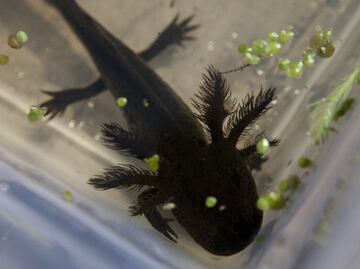Más Información

ONU llama a investigar asesinato del periodista Alejandro Gallegos en Tabasco; “nos solidarizamos con su familia”, dice

Loret de Mola denuncia cierre de la cuenta de Latinus en Tiktok; ocurre en medio de debate sobre libertad de expresión
Full of legends and flavors, Xochimilco is an ancient place characterized by its rain canals, from when the Valley of Mexico was surrounded by lakes and lagoons.
Xochimilco means “field of flowers” and a big part of its nature still prevails, along with its cultural elements from pre-Hispanic origin: farmers use the canals for transportation, the locals are very involved in the production of ornamental plants and landscaping.
This oasis is the third most visited destination in Mexico City and it is full of interesting places to visit.
Here are just a couple of them for your next visit .
The Island of the Dolls
This island is located in a chinampa (an islet of sorts) in Xochimilco. Owned by Mr. Julian Santana Barrera , the place is full of dolls that despite the absence of their owner, who passed away in 2001, are still in the old house, which is now a museum . They are hanging in the trees and the wooden fence that gives the chinampa a grim look . The dolls are dirty, their hair is not combed, and some of them lack eyes. Sometimes the mechanisms that make them laugh or cry are activated, which makes them seem alive .
Mr. Julián Santana Barrera
, also known as “La Coquita,” was a man who lived in a chinampa in Xochimilco. He did not like to talk to anybody and he only left his chinampa to sell his harvest in the Xochimilco street market.
The legend tells that during the 1950s , a girl drowned near the chinampa of Mr. Santana, and from that moment on, c ries, steps, and female voices could be heard in the place.
“La Coquita” decorated his islet with dolls that he had recollected or that he had found floating in the water in order to drive evil spirits away and to have better crops.
He had a favorite doll called “La Moneca” which he moved among the huts he had in his chinampa. One of the huts was full of l ittle figures of mules he made with corn leaves and that he hanged. There were also crosses made by himself, as well as photographs of politicians, Xochimilco delegates, artists, students, and other people who visited him, according to professor Sebastián Flores Farfán , chronicler of Xochimilco.
Fifty years after the death of the girl, Santana Barrera went near the place where she died to start his daily activities, which included singing to the mermaid that wanted to take him with her, which scared her.
That day, he could not drive the mermaid away. Mr. Julián fell dead exactly in the same place where the girl had died fifty years before. His body was found floating in front of his chinampa, in the Tezhuilo lagoon .
The Island of the Dolls became popular during the 1990s during an ecological rescue in Xochimilco. Since then, tourists that have visited the place assert having had paranormal experiences with the dolls. Others visit the island to ask a favor to “La Moneca.”
The nephew of Mr. Julián, who has passed away too, was the one in charge of the guided tours and show his uncle’s “heritage.”
According to the tradition, all visitors must leave some coins to “La Moneca” so that evil spirits do not follow them during the tour. If visitors dare, they can camp in front of the islet, where there is a designated space for it.
If you want to visit the Island of the Dolls, you can join an ecological tour that includes the visit to greenhouses, Caltongo lagoon, Xaltocán lagoon , and the ecological area of Xochimilco . The trajinera must be boarded before 2 p.m. in order to be able to visit the Island of the Dolls. The tour is 5 hours long and has a cost of MXN $2,000 , which does not include the access to the Island, which is directly paid at the chinampa and costs MXN $40 per person.
Xochiquetzalli
Another important place in Xochimilco is 45 minutes away in trajinera, which is a traditional Mexican boat moved manually. Xochiquetzalli is a cooperative of small farmers that teaches the ancient method of planting , an activity that made Xochimilco be appointed a World Heritage Site by Unesco.
Visitors help to t race the paths and deposit seeds that will sprout as fruits, vegetables, and flowers.
In this space, there is a recess to eat barbacoa and quesadillas made at the time. After that, visitors can buy medicinal plants or a food basket for truly affordable prices.
Another interesting place to visit in Xochimilco is the Museum of the Axolotl , which is focused on the study of this amphibian which has the characteristic of regenerating any part of its body and which is also in danger of extinction.
The tour to Xochiquetzalli lasts for 5.5 hours. The trajinera has a capacity of up to 20 persons. Cost: MXN $2200 .
The tour can be combined with a workshop on the elaboration of traditional Mexican crystallized sweets .
mp










